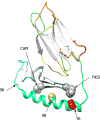HLA-DQA1 and APOL1 as Risk Loci for Childhood-Onset Steroid-Sensitive and Steroid-Resistant Nephrotic Syndrome
- PMID: 29277510
- PMCID: PMC5828864
- DOI: 10.1053/j.ajkd.2017.10.013
HLA-DQA1 and APOL1 as Risk Loci for Childhood-Onset Steroid-Sensitive and Steroid-Resistant Nephrotic Syndrome
Abstract
Background: Few data exist for the genetic variants underlying the risk for steroid-sensitive nephrotic syndrome (SSNS) in children. The objectives of this study were to evaluate HLA-DQA1 and APOL1 variants as risk factors for SSNS in African American children and use classic HLA antigen types and amino acid inference to refine the HLA-DQA1 association.
Study design: Case-control study.
Setting & participants: African American children with SSNS or steroid-resistant nephrotic syndrome (SRNS) were enrolled from Duke University and centers participating in the Midwest Pediatric Nephrology Consortium.
Factor: Genetic variants in HLA-DQA1 (C34Y [rs1129740]; F41S [rs1071630]) and APOL1 high-risk alleles.
Outcomes: SSNS and SRNS.
Measurements: Direct sequencing for the HLA-DQA1 and APOL1 variants in 115 African American children (65 with SSNS and 50 with SRNS). Imputation of classic HLA alleles and amino acids was done in 363 South Asian children.
Results: The 2 HLA-DQA1 variants were significantly associated with SSNS in African American children (C34Y: P=5.7 × 10-11; OR, 3.53; 95% CI, 2.33-5.42; F41S: P=1.2 × 10-13; OR, 4.08; 95% CI, 2.70-6.28), but not with SRNS (C34Y: P=0.6; F41S: P=0.2). APOL1 high-risk variants were not associated with SSNS (P=0.5) but showed significant associations with SRNS (P=1.04 × 10-7; OR, 4.17; 95% CI, 2.23-7.64). HLA-DQA1*0201, HLA-DQB1*0201, and HLA-DRB1*0701 were the classic HLA alleles with the most significant associations with SSNS risk. The most significantly associated amino acid positions were HLA-DQα1 56 and 76 (both P=2.8 × 10-7). Conditional analysis revealed that these variants most likely account for the observed association.
Limitations: Modest sample size and limited statistical power to detect small to moderate effect sizes. Children studied may not be representative of all African American children in the United States.
Conclusions: HLA-DQA1 is a risk locus for SSNS, but not SRNS, in African American children, consistent with its role in SSNS risk in children of European, Asian, and African ancestries. There is little evidence of a significant role for the APOL1 high-risk alleles in childhood SSNS in African American children. Refinement of the HLA-DQA1 association identified the critical classic HLA antigen types and amino acids of the HLA-DQ α1 molecule.
Keywords: APOL1; African American; HLA-DQA1; Nephrotic syndrome; SRNS; SSNS; childhood; corticosteroids; ethnic disparities; genetics; kidney disease; nonmodifiable risk factor; pediatric kidney disease; risk loci; steroid sensitivity.
Copyright © 2017 National Kidney Foundation, Inc. All rights reserved.
Conflict of interest statement
Figures

References
-
- Niaudet P. Steroid-resistant idiopathic nephrotic syndrome in children. In: Avner ED, Harmon WE, Niaudet P, editors. Pediatric Nephrology. Philadelphia: Lippincott Williams & Wilkins; 2004. pp. 557–573.
-
- Eddy AA, Symons JM. Nephrotic syndrome in childhood. Lancet. 2003;362(9384):629–639. - PubMed
-
- Bonilla-Felix M, Parra C, Dajani T, et al. Changing patterns in the histopathology of idiopathic nephrotic syndrome in children. Kidney Int. 1999;55(5):1885–1890. - PubMed
Publication types
MeSH terms
Substances
Grants and funding
LinkOut - more resources
Full Text Sources
Other Literature Sources
Research Materials
Miscellaneous

